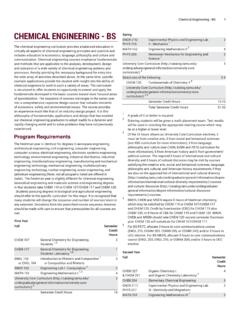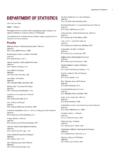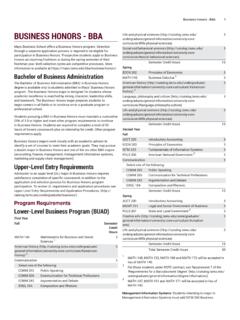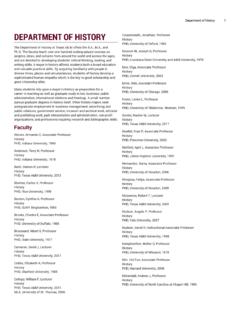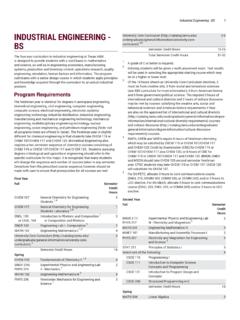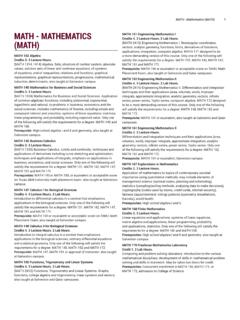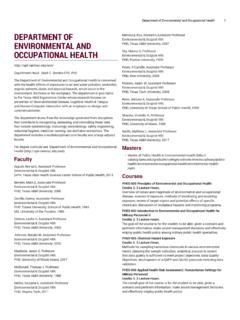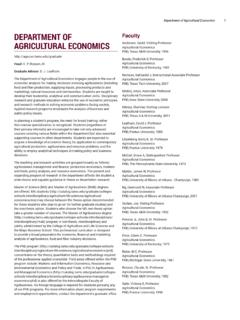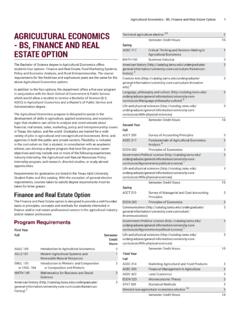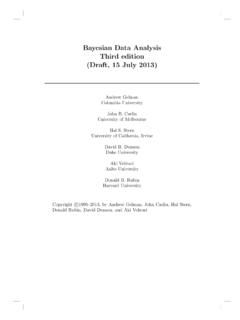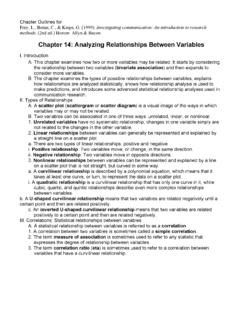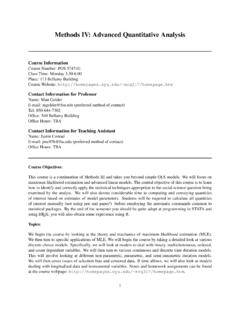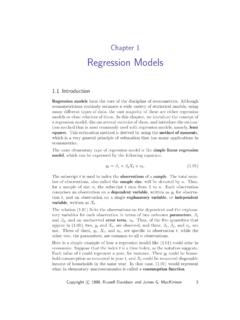Transcription of STAT - Statistics
1 STAT - Statistics 1 STAT - STATISTICSSTAT 601 Statistical AnalysisCredits 4. 3 Lecture Hours. 2 Lab students in engineering, physical and mathematical to probability, probability distributions and statisticalinference; hypotheses testing; introduction to methods of analysis suchas tests of independence, regression , analysis of variance with someconsideration of planned : MATH 152 or MATH 604 Topics in Statistical ComputationsCredits 3. 3 Lecture uses of existing statistical computer programs (SAS, R, etc.);generation of random numbers; using and creating functions andsubroutines; statistical graphics; programming of simulation studies; anddata management : MATH 221, MATH 251, or MATH 605 Advanced Statistical ComputationsCredits 3. 3 Lecture languages, statistical software and computingenvironments; development of programming skills using modernmethodologies; data extraction and code management; interfacing lower-level languages with data analysis software; simulation; MC integration;MC-MC procedures; permutation tests; : STAT 612 and STAT 607 SamplingCredits 3.
2 3 Lecture , execution and analysis of sampling from finite populations;simple, stratified, multistage and systematic sampling; ratio : STAT 601 or STAT 652 or concurrent enrollment inSTAT 608 regression AnalysisCredits 3. 3 Lecture , curvilinear, nonlinear, robust, logistic and principal componentsregression analysis; regression diagnostics, transformations, analysis : STAT 601 or STAT 610 Theory of Statistics - Distribution TheoryCredits 3. 3 Lecture introduction to probability theory; distributions and expectationsof random variables, transformations of random variables and orderstatistics; generating functions and basic limit : MATH 409 or concurrent enrollment in MATH 611 Theory of Statistics - InferenceCredits 3. 3 Lecture of estimation and hypothesis testing; point estimation, intervalestimation, sufficient Statistics , decision theory, most powerful tests,likelihood ratio tests, chi-square : STAT 610 or 612 Theory of Linear ModelsCredits 3.
3 3 Lecture algebra for statisticians; Gauss-Markov theorem; estimability;estimation subject to linear restrictions; multivariate normal distribution;distribution of quadratic forms; inferences for linear models; theory ofmultiple regression and AOV; random-and mixed-effects : Course in linear 613 Statistical Methodology ICredits 3. 3 Lecture of likelihood inference; exponential family models; grouptransformation models; survival data; missing data; estimation andhypotheses testing; nonlinear regression models; conditional andmarginal inferences; complex models-Markov chains, Markov randomfields, time series, and point : STAT 614 Probability for StatisticsCredits 3. 3 Lecture and measures; expectation and integrals, Kolmogorov'sextension theorem; Fubini's theorem; inequalities; uniform integrability;conditional expectation; laws of large numbers; central limit theoremsPrerequisite: STAT 610 or its 615 Stochastic ProcessesCredits 3.
4 3 Lecture of the theory of stochastic processes; includes countable-stateMarkov processes, birth-death processes, Poisson point processes,renewal processes, Brownian motion and diffusion processes andcovariance-stationary processes; theoretical development andapplications to real world : STAT 610; MATH 616 Statistical Aspects of Machine Learning I: ClassicalMultivariate MethodsCredits 3. 3 Lecture methods from traditional multivariate analysis and variousextensions; probability distributions of random vectors and matrices,multivariate normal distributions, model assessment and selection inmultiple regression , multivariate regression , dimension reduction, lineardiscriminant analysis, logistic discriminant analysis, cluster analysis,multidimensional scaling and distance geometry, and : STAT 612, STAT 618 Statistical Aspect of Machine Learning II: Modern TechniquesCredits 3.
5 3 Lecture course in statistical machine learning; recursive partition andtree-based methods , artificial neural networks, support vector machines,reproducing kernels, committee machines, latent variable methods ,component analysis, nonlinear dimensionality reduction and manifoldlearning, matrix factorization and matrix completion, statistical analysisof tensors and multi-indexed : STAT 612, STAT 613, and STAT 620 Asymptotic StatisticsCredits 3. 3 Lecture of basic concepts and important convergence theorems;elements of decision theory; delta method; Bahadur representationtheorem; asymptotic distribution of MLE and the LRT Statistics ;asymptotic efficiency; limit theory for U- Statistics and differentialstatistical functionals with illustrations from M-,L-,R-estimation; : STAT 621 Advanced Stochastic ProcessesCredits 3.
6 3 Lecture expectation; stopping times; discrete Markov processes;birth-death processes; queuing models; discrete semi-Markov processes;Brownian motion; diffusion processes, Ito integrals, theorem and limitdistributions; differential statistical functions and their limit distributions;M-,L-, : STAT 614 or STAT STAT - StatisticsSTAT 623 Statistical methods for ChemistryCredits 3. 3 Lecture topics of process optimization, precision and accuracy;curve fitting; chi-squared tests; multivariate calibration; errors incalibration standards; Statistics of : STAT 601, STAT 641 or STAT 652 or approval of 624 Databases and Computational Tools Used in Big DataCredits 3. 3 Lecture of common tools used by statisticians for high performancecomputing and big data type problems; shell scripting; HPC clusters;code optimization and vectorization; parallelizing applications usingnumerical libraries; open MP, MPI and parallel R; data management andrevision control using Git; exploration of SQL, survey NOSQL databases;introduction to : Knowledge of R, Fortran, or 626 methods in Time Series AnalysisCredits 3.
7 3 Lecture to statistical time series analysis; autocorrelation andspectral characteristics of univariate, autoregressive, moving averagemodels; identification, estimation and : STAT 601 or STAT 642 or approval of 627 Nonparametric Function EstimationCredits 3. 3 Lecture function estimation; kernel, local polynomials, Fourierseries and spline methods ; automated smoothing methods includingcross-validation; large sample distributional properties of estimators;recent advances in function : STAT 630 Overview of Mathematical StatisticsCredits 3. 3 Lecture probability theory including distributions of random variables andexpectations. Introduction to the theory of statistical inference fromthe likelihood point of view including maximum likelihood estimation,confidence intervals, and likelihood ratio tests.
8 Introduction to : MATH 221, MATH 251, and MATH 631 Statistical methods in FinanceCredits 3. 3 Lecture and the capital asset pricing model, Statistics for portfolioanalysis, resampling, time series models, volatility models, option pricingand Monte Carlo methods , copulas, extreme value theory, value at risk,spline smoothing of term : STAT 610, STAT 611, STAT 632 Statistical Methodology II-Bayesian Modeling and InferenceCredits 3. 3 Lecture theory; fundamentals of Bayesian inference; single and multi-parameter models; Gaussian model; linear and generalized linear models;Bayesian computations; asymptotic methods ; non-iterative MC; MCMC;hierarchical models; nonlinear models; random effect models; survivalanalysis; spatial : STAT 633 Advanced Bayesian Modeling and ComputationCredits 3. 3 Lecture methods in their research; methodology, and applications ofBayesian methods in bioinformatics, biostatistics, signal processing,machine learning, and related : STAT 608, STAT 613, STAT 636 Applied Multivariate AnalysisCredits 3.
9 3 Lecture extension of the chi-square and t-tests, discriminationand classification procedures; applications to diagnostic problems inbiological, medical, anthropological and social research; multivariateanalysis of variance, principal component and factor analysis, : MATH 304, STAT 638 Introduction to Applied Bayesian MethodsCredits 3. 3 Lecture regarding parameters and how they can be explicitlydescribed as a posterior distribution which blends information froma sampling model and prior distribution; emphasis on modeling andcomputations under the Bayesian paradigm; includes prior distributions,Bayes Theorem, conjugate and non-conjugate models, posteriorsimulation via the Gibbs sampler and MCMC, hierarchical : STAT 630, or equivalent or approval of 639 Data Mining and AnalysisCredits 3. 3 Lecture overview of data mining, integrating related concepts frommachine learning and Statistics ; exploratory data analysis, patternmining, clustering and classification; applications to scientific and Listing: ECEN 758 and CSCE 641 The methods of Statistics ICredits 3.
10 3 Lecture application of the various disciplines in Statistics to data analysis,introduction to statistical software; demonstration of interplay betweenprobability models and statistical : Concurrent enrollment in STAT 610 or approval 642 The methods of Statistics IICredits 3. 3 Lecture and analysis of experiments; scientific method; graphicaldisplays; analysis of nonconventional designs and experiments involvingcategorical : STAT 643 Biostatistics ICredits 3. 3 Lecture for quantitative and quantal responses: statistical analysisof contingency, including effect estimates, matched samples : STAT 608, STAT 630, and STAT 642 or STAT 644 Biostatistics IICredits 3. 3 Lecture linear models; survival analysis with emphasis onnonparametric models and : STAT 643 or approval of 645 Applied Biostatistics and Data AnalysisCredits 3.
